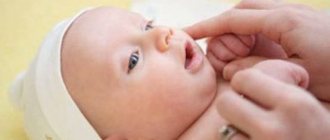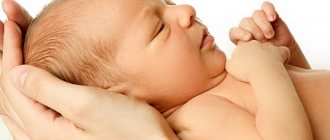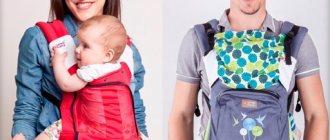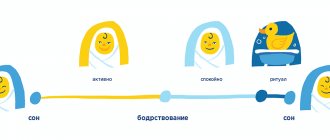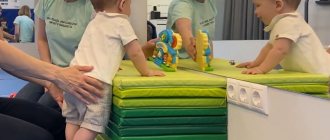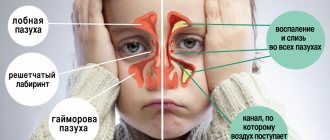4 minutes Author: Anastasia Egorova 2370
- The essence of the reflex
- What is considered normal
- What should you be wary of?
Reflexes play an important role in human life. They can be conditional or unconditional, congenital or acquired, but one way or another they are the main form of activity of the nervous system. When a newborn is born, he has his own set of physiological innate reflexes, about 15 of them. They help him adapt to the world around him, because at this stage he does not understand much, the child has not yet formed behavioral stereotypes.
Each reflex in infancy has its own important goal: to protect (Moro reflex), satisfy the need for nutrition (sucking, proboscis, searching), and provide the opportunity to breathe freely. In this article we will look at how the Moro reflex manifests itself in newborns, its characteristics and the time of extinction.
The essence of the reflex
The Moro reflex can be observed immediately after birth. Thus, obstetricians and neonatologists test the baby for various reactions, which, in turn, can show the state of the nervous system and whether there are any abnormalities in brain activity.
The essence of the test is as follows: the baby is placed on a flat, hard surface on his back. Then the doctor hits the surface with his hand at a palm distance (about 15 cm) from the baby’s head or makes a loud bang. As a response, the baby's arms sharply throw back, he moves them symmetrically to the sides, straightening his fists. This is the so-called first phase of the reflex, lasting several seconds. In the second phase, the handles slowly return to their original position, the cams are compressed.
Similar symptoms are also observed if a baby is held in your arms, lifted up, and then sharply lowered down. Another check is this: the legs of a baby lying on his back are straightened and they are lifted together with the pelvis, as if upward. The reaction with handles will be the same.
When does the reflex go away? Complete extinction occurs at approximately 6 months. Up to 4 months it is quite well expressed, and from 4 to 6 only its individual fragments can be observed.
What should be the conditions for assessing the Moro reaction? It is very important that at the time of the test the baby is calm, moderately full (recommended in the morning - 2 hours after feeding) and healthy.
How is the reaction in a newborn checked?
Before testing, the child must be completely healthy, reasonably well fed and well rested. The most optimal time is the first half of the day, 1.5-2 hours after feeding.
The reflex is tested in several ways:
- Clap your hands loudly in front of the baby's face.
- The child is picked up, lifted up, and then sharply lowered down.
- The newborn lies on his back. The child's legs are straightened and sharply raised upward along with the pelvis. The response should manifest itself in a similar way if you press the baby’s arms tightly to his chest and then abruptly release them.
- At a distance of approximately 20 cm from the head of the lying child, make a sharp clap on the surface of the mattress.
During any of the listed test options, the child opens his arms wide to the sides with open palms, and then returns them to their original position. The mechanism of action is very similar to the fact that the baby is urgently trying to grab onto someone or something at this moment of perceived danger.
It is best to conduct dynamic testing during a massage or playing with a child. It is definitely worth taking into account the peculiarities of the child’s nervous activity. How bright the reflex is will depend on this. For example, an easily excitable baby will have an active reaction, while a phlegmatic baby may react rather sluggishly, but this is still not a reason to talk about deviations from the norm.
It is advisable to repeat the test periodically for as long as the reflex should be present: until the baby is 6 months old. The best option is once every 14 days.
https://youtube.com/watch?v=yLeNhiQlVyI
What is considered normal
During the test, the following reaction in a baby is considered normal:
- fright, crying of a baby;
- rapid heartbeat, increased breathing;
- release of adrenaline into the blood.
This is the norm, since these manifestations indicate that the central nervous system (CNS) reacts correctly and quickly. The Moro reflex in a newborn can be observed in everyday life, for example, with loud noises on the street, the doorbell rings, and sometimes the child may flinch in his sleep.
Despite all the so-called “norms” of the study, it should be understood that at the moment of flinching and spreading the arms, a strong fear occurs, as if the baby is trying to grab onto his mother or someone close, feeling danger.
Therefore, it would be wrong to show “tricks” with your child to friends and acquaintances, every now and then causing manifestations of the reflex for the purpose of entertainment. Rather, on the contrary, it is necessary to try to minimize the possible causes of fear and eliminate irritating factors that can negatively affect the child’s psyche. At the same time, there is no need to worry too much if you notice that when hearing sharp sounds, the baby opens its arms and begins to cry.
Symptoms
Moro syndrome allows the baby to take its first breath when leaving the birth canal.
Subsequently, the correct symptoms can be checked as follows:
- Lightly and unexpectedly hit the pillow on which the newborn's head rests. At the same time, the child’s arms, which were previously in a half-bent position, move apart and the fingers spread out.
- If you suddenly slightly stretch the child's legs, he creates a movement of his arms similar to the first situation. The arms move to the side, the fingers expand, and then everything returns to its original position.
- You can check it in another way. Slam the changing table on which the baby is lying. In response, he will spread his arms and straighten his bent legs. After 2-3 seconds. will return to its original position. You can also take the child by the hind legs and slightly stretch them out and lift them. The reaction will be the same.
This is a normal reactive state, on the basis of which it is concluded that the child’s reflexes are fine. This syndrome should normally be present for up to 4–5 months.
Moro reflex
In the future, you should carefully monitor the baby’s involuntary movements.
If a child often spreads his arms for no reason, and his movements are asymmetrical, then you should pay attention to this and seek advice from a pediatrician
In infancy, the syndrome is triggered by the sensory system, but if it does not go away in later life, it causes problems
The adrenal glands begin to work in increased mode, which leads to hyperactivity and subsequently problems with attention.
Once the adrenal glands become tired from overstimulation, the child typically develops chronic allergies, asthma, autoimmune and other health problems associated with adrenal fatigue. In addition, when the body is constantly in "crisis mode", the brain is in an excited state and cannot store or perceive information. This leads to further problems in learning.
In subsequent years, one can observe clinical manifestations of the pathological activity of the reflex, which was not completed in infancy:
- aggressiveness;
- isolation;
- increased sensitivity;
- difficulty communicating with others;
- immature emotions;
- increased imagination.
Changes also occur at the hormonal level:
- decreased cortisol production;
- excess norepinephrine;
- blood deposition (its accumulation in venous vessels).
What should you be wary of?
When assessing the baby’s reaction, pay attention to the severity of the reflex effect: it is weak, normal or too bright, appears quickly or late, etc. If deviations from the norm are noticed, the child is sent for examination. The following factors should be of concern:
Asymmetry. During the test, the handles do not recline symmetrically. This is a bad sign for any reflex, as it indicates intracranial injury or problems with the central nervous system. Asymmetry is often observed in neurological syndromes, such as paresis. We can say that paresis is an incomplete paralysis in which the motor pathways of the nervous system are damaged, as a result of which motor activity is limited.
Spontaneous reflex. It is expressed by the fact that the baby moves his arms to the sides even in the absence of cotton or any other irritant. This may indicate the development of intracranial pressure, so neurosonography and other examinations are required.
The absence of a reflex occurs when brain activity is damaged and is detected in the delivery room. Often in such cases, several reflexes are suppressed or completely absent, and the newborn has a low Apgar score. This can happen during difficult childbirth, extreme prematurity, or oxygen starvation of the fetus.
Incomplete reflex. It is observed when the baby throws his arms back slightly and indicates the development of hypertension. The specialist is able to assess the threshold of the Moro reflex. The lower it is, the greater the likelihood of damage to the central nervous system. In children with brain disorders, reflex activity may not fade away for a long time.
With severe brain disorders, as well as with malfunctions of the central or peripheral nervous system, reflex damage will not be the only symptom. The child is additionally examined by neurologists and neonatologists and, depending on the diagnosis and severity of the disease, treatment is prescribed. Often the treatment regimen includes a course of massage, which helps relieve muscle tone, as well as taking nootropic drugs that improve cerebral circulation.
Fortunately, in most cases, the reflexes of young children work smoothly and do not cause any concern.
- Features of the reflex
- Norm or pathology
- What else to pay attention to
- Why do reflexes change?
If missing, what should I do?
A delay in the appearance of the Moro reflex can be caused by oxygen starvation of the newborn during childbirth, for example, due to entanglement in the umbilical cord. In this case, he needs good care, quality nutrition and appropriate treatment, which will be prescribed by a pediatrician. A little later, everything will return to normal, and the reaction will manifest itself in full.
Incomplete reproduction of the action, when he only slightly moves his arms, when checking for Moro, the baby may experience it if he suffers from high blood pressure. This is also possible in case of birth intracranial injury, up to a delay in the onset of the reaction. In this case, the doctor will prescribe the correct restorative and supportive therapy.
But if at the same time the child’s several basic reflexes fade or are absent, then this is a serious reason to contact a competent doctor. This indicates depression of higher nervous activity due to severe brain damage, which causes depression syndrome. Consultation with a specialist and identification of the cause of such deviations should be carried out immediately.
The complete absence of the Moro effect in a baby is a very serious symptom, which may mean damage to the brain stem or cervical vertebrae. It can also be a symptom of severe traumatic brain injury, cerebral edema, cerebral hemorrhage and indicate cerebral lesions.
Important! If any deviations in the Moro reaction occur, parents should immediately contact their pediatrician. Examination and treatment can only be carried out under the close supervision of a physician.
Self-medication is unacceptable, as it can cause irreparable harm to the child’s health!
The Moro reflex is one of the first innate reactions that appears in a baby. It carries great biological meaning, since it is not only a condition for the child’s survival, as it was intended by nature, but also acts as an indicator of the functioning of the baby’s central nervous system.
Features of the reflex
The reflex was first described as an obligatory automatism in a newborn by the German pediatrician Moro in the 20th century. This phenomenon is congenital; it is involuntarily caused by obstetricians already during the treatment of the child after birth.
To trigger the reflex, it is enough to use one of the following techniques:
- sharply hit the table at a distance of 30 cm from the child;
- quickly raise and lower the child to a small height, holding in his hands;
- while lying on your back, take the newborn’s ankles in your hand and lift your legs up to your waist;
- carefully but suddenly straighten your lower limbs.
A small child is characterized by muscle hypertonicity (increased tone). Therefore, normally, his arms are brought towards the body, and his fingers are clenched into a fist. With the Moro reflex, symmetrical bilateral movements are observed that go through two phases:
- The fists unclench, the fingers fan out, the arms are spread out to the sides.
- Bringing your hands back into place, your fists clenched again.
It is important that synchronous movement of the newborn's hands is observed. If the doctor notices that the reflex lags in one of the phases, this will give a signal to pay attention to the child and conduct an additional examination.
Defensive reflexes
Help the child defend himself. They disappear as they develop control over their movements.
Check: Place the baby on his back. Take the toy and lift it above the child's head to a height of about 30 cm, and then slowly bring it closer to his face. The child should turn his head to the side.
If a newborn baby is placed on his stomach, he must also reflexively turn his head to the side so as not to suffocate.
The well-known phenomenon of newborn swimming is based on the “duck” reflex - the baby’s ability to hold his breath. It also applies to protective reflexes.
"Duck" reflex
The child also has a number of reflexes that remain with him throughout his life. For example, the gag reflex; withdrawal reflex, in response to painful sensations; pupillary reflex, when in bright light the pupil of a newborn narrows. Innate reflexes either disappear over time or develop into motor skills.
Norm or pathology
The Moro reflex in newborns is considered a normal reaction of the body during the first few months. It is impossible to say for sure when automaticity passes; it is individual. A decrease in severity is observed already from 4 months; at 5 months, individual elements of automatism may remain, but it should not be pronounced.
By 6-7 months in healthy children, the reflex should fade away completely. If it persists for up to 7 months or more, this indicates a possible pathology of the infant.
Babies' reactions
Newborns have the following reflexes:
1. Moro reflex. Another reaction is called the startle reflex. If you very quickly remove the hand supporting the baby, the baby will immediately try to cling to something. In this case, the face will be frightened and everything will end in a scream. The involuntary grasping movement is a defensive reaction. This reflex is most pronounced in the first month of his life. Gradually disappears by the 5th month of life.
2. Reflexes of maintaining the correct position. These reactions help the baby hold his torso, arms, legs, and head. If you put your baby on his tummy, he will try to raise his head. The child will turn his head to the side to allow air to enter.
3. Gag reflex. At the moment when a child learns to swallow and suck, he pushes foreign objects out of the mouth. When exposed to the back of the pharynx, the tongue will produce a pushing action. This reaction remains with a person for the rest of his life. But the tongue will be used only in the first six months of life.
What else to pay attention to
When assessing the neurological status of a child, not only the Moro reflex is taken into account, but also other automatisms. If their severity or order of extinction changes, pathology in a certain part of the nervous system can be suspected. Neurologists determine the following automatisms in newborns:
- Babkin's reflex, or palm-oral reflex - if the doctor presses his thumb simultaneously on the palms of both hands of the baby, he opens his mouth and bends his head. Completely disappears by 3 months;
- Babinski reflex - caused by line irritation of the foot in the toe area, the baby dorsiflexes the foot, and the toes spread to the sides like a fan, can last up to 1.5 years;
- Galant reflex - gives the newborn an unpleasant sensation - when pressing with a finger along the vertebrae on one side, the child reflexively bends towards the stimulus. In this case, the leg is extended and stretched to the same side. Normally, the reflex fades away at 3-4 months.
The doctor can check other automatisms that will indicate the child’s normal development or possible pathology. Grasping and proboscis reflexes, as well as search reflexes, are important.
Babinski reflex in children
Study published in the International Journal of Physiology
, showed that the Babinski reflex occurs in approximately 62-75% of newborns. Because newborns usually do not yet have a fully developed nervous system, the reflex is not a sign of neurological disease.
Although the reflex reaction is normal in infants, it should be absent after 24 months of life. In some cases, the reflex reaction disappears earlier - already at the age of 1 year. Doctors believe that Babinski's reflex, which occurs in adults or children over 2 years of age, is an abnormal reflex reaction. This may be a sign of an underlying neurological condition or nervous system disorder.
Why do reflexes change?
A reflex is the body’s response to a specific stimulus. By their severity and strength one can judge the state of the baby’s nervous system. Normally, the Moro reflex is observed from birth. If it is expressed unevenly, one side reacts more brightly than the other, hemiparesis is suspected. This is a pathological lesion of the nervous system on the part of one hemisphere, leading to weakness in the arm and leg, up to the complete impossibility of independent movements. If a traumatic brain injury occurs during childbirth, then automatism is absent immediately after birth; in a mild form, it may appear after 1-2 days.
The Moro reflex changes in intracerebral hypertension. The higher the intracranial pressure, the less pronounced the automatism, sometimes it becomes incomplete: when hitting the table, the baby spreads his arms slightly to the sides and immediately returns them back.
With birth trauma to the brain, other reflexes also change. The child may not have expressed palmo-oral, searching, sucking and proboscis automatisms.
With pathology of the nervous system, not only long-term preservation of automatism is observed, but also its appearance at the wrong moment. It can appear during normal manipulations, during crying and restlessness of the baby.
Reflex responses of newborn children are direct signs of normal functioning of the nervous system. Not only the long-term persistence of the response is dangerous, but also its disappearance ahead of time and a change in activity. Therefore, children who have suffered acute hypoxia during labor and extraction using a vacuum extractor should be observed by a neurologist.
Also interesting to read: bronchiolitis in children
Moro reflex in a baby photo
Moro reflex in a baby is a concept not familiar to many young mothers. As a rule, new mothers confuse this reflex with increased nervousness of the baby. Despite the fact that this reflex is normal and natural for babies, there are some nuances. The bottom line is that it can appear during the first few months, however, if it does not go away after 5 months of age, then it should cause mild concern for parents.
Reflexes of babies and their meaning
In many people's minds, a newborn baby is a blank slate, a tabula rasa. Actually, some scientists also adhere to this opinion, in particular, for example, the philosopher John Locke introduced this concept into use. Nevertheless, from time immemorial, people have observed that children, even in the first minutes of life, exhibit some unconditional reactions that arise in absolutely everyone and manifest themselves in the same way. Such reactions are called innate unconditioned reflexes.
Unconditioned reflexes are a kind of baggage of adaptive mechanisms with which a baby is born
And while the baby is not able to take care of itself, Mother Nature can do it for him. Important! The meaning of all innate reflexes is that they perform a life-sustaining function and contribute to the child’s adaptation to the environment
Today, in medical and obstetric practice, congenital reactions are one of the first criteria that a neonatologist checks in the maternity hospital immediately after birth. The presence of reflexes is the norm for all newborns, but the absence of any of them, its weak degree or asymmetry of manifestation can, already in the first minutes after birth, help the doctor to suspect any abnormalities in the functioning of the central nervous system in the baby and immediately take measures to promptly cure the baby from possible serious pathologies. Neonatologists identify more than a dozen reflexes, which are subject to testing in the maternity hospital. In addition, monitoring of the baby’s reflex activity will then be carried out by a visiting nurse in the first weeks at home and by a pediatrician in the clinic in the future.
Some of the unconditioned reactions are temporary and disappear immediately after birth, since they were aimed specifically at helping the baby overcome the birth process. Other reflexes appear in the first minutes and hours of life, but after a few months (usually up to 3-4 months or until the end of the first year of life) they gradually fade away and then disappear altogether. But the third reflexes, on the contrary, appear only over time.
Mothers will be interested to know: what is normal weight gain, when the baby begins to hold his head up and roll over on his side on his own, how the child’s height increases month by month, when to start the first feeding of an infant, and also read: how to teach a child to go to the potty, sit, crawl and talk.
The main innate reactions of the infant include the following reflexes:
- sucking - if you immerse a pacifier, teat or fingertip into a baby’s mouth, he will begin to perform active sucking actions;
- search - if you lightly rub the corner of the baby's mouth with the tip of your finger without touching his lips, he will turn his head in the direction of touch and lower his lower lip as if in search of his mother's breast. This reaction usually disappears about a month and a half after birth;
- proboscis - if you lightly tap the baby’s lips, he will pull them forward in the form of a proboscis. This occurs due to contraction of the orbicularis oris muscle;
- grasping - if you put something into the baby’s palms, for example, your fingers, then he will involuntarily grab tightly, clenching his palms into fists. Sometimes the reflex is so strong that the little one can even be lifted into a vertical position, it holds on so tightly;
- Babinsky - try to run your finger, pressing lightly, along the baby’s foot, starting from the edge of the heel to the base of the toes. At the same time, the baby’s toes will spread out in the form of a fan. And then press on the area between the second and third fingers - the fingers will bend again;
- supports - if, carefully holding the head, you take the baby under the armpits and place him vertically on the changing table, then the baby will rest on the entire sole, straighten up, as if “standing” on two legs;
- automatic walking is a continuation of the previous reflex. Try to tilt the “standing” baby slightly forward, and he will begin to “walk” along the surface, sometimes his legs may even cross, but it still looks like a gait;
- Bauer crawling - consists of placing a palm on both feet and applying light pressure to the legs of a baby lying on his stomach. At this moment, the baby seems to rest his feet on his palm and push off “crawling”;
- and, of course, the Moro effect, which in infants manifests itself in the form of a specific fearful reaction to an irritating factor.
What is the Moro child's reflex? Should parents worry, or is this a natural phenomenon?
A baby is born with a whole set of natural reflexes, with the help of which he survives in a new world. Unfortunately, the child does not have instructions, and therefore many young parents begin to panic when faced with some phenomenon that was previously unfamiliar to them. As a rule, most parents get scared when their baby throws up his arms. A similar phenomenon was called the Moro reflex.
This phenomenon is also commonly called the startle reflex. New parents, not aware of its existence, turn to the pediatrician with the question of why their baby throws up his arms for no reason. And some even grab the baby and run with him to the neurologist. The Moro reflex is present in newborns, but it quickly fades away over the course of several months. The presence of this reflex is checked by a neonatologist. He lays the baby on his back and removes his hand from under it. In addition, the Moro reflex occurs with an unexpected, loud sound, for example, with a sharp clap near the crib where the newborn is lying.
Parents, who know that this phenomenon is quite normal, even consider such a reaction of the baby funny, and therefore occasionally cause it on purpose, for example, to amuse their friends. Doing this is strictly prohibited! Despite the fact that the Moro reflex in itself is not dangerous, the baby does not throw up his arms because he is happy. This action is provoked by tremendous fear, since the baby is sure that he is falling, and therefore strives to grab onto his mother. We can say that he is actually saving his life. A newborn cannot yet understand that he is safe. That is, every time the Moro reflex is triggered, it is a real stress for the child’s body.
Parents may not notice, but every time this reflex occurs, the baby’s breathing and heartbeat quicken, and an increased dose of adrenaline is produced. Often, after throwing up the arms, the baby begins to cry. We can say that for a newborn the Moro reflex is a strong fear.
It goes without saying that it will not be possible to completely avoid the manifestation of the reflex. In particular, if there are pets in the house, the family lives on a noisy street, or the baby has young brothers and sisters. Throwing up the arms can be triggered by a loud sound, a sudden movement of a parent with a baby in their arms, an excessively fast movement of putting them into a crib, etc. In addition, the Moro reflex in the same newborn can manifest itself even with minor factors, but, on the contrary, it cannot be observed with loud sounds. For parents, this situation should not cause concern.
As a rule, the Moro reflex completely disappears after 9–12 weeks of the baby’s life. However, if the reflex persists for a longer period and does not fade even after 5 months of age, then the baby should be shown to a specialist. In addition, the absence of this reflex or its distortion indicates problems with children's health. You must always carefully monitor what is happening to the baby, how he reacts to the environment.
To assess the health of a newborn baby, unconditioned reflexes are of great importance. By their manifestation or absence, one can judge whether everything is okay with the baby and whether the baby requires additional examination and treatment. One of the important innate reflexes of a newly born child and growing infant is the Moro reflex.
How to test your reflex
The Moro reflex in toddlers is a spontaneous reaction, therefore, if you want to check at home whether everything is okay with this in your baby, then you need to perform several specific actions that cause this reaction:
- put the child on the changing table, while the situation around him should be quite familiar to him, everything is quiet and calm. Sharply hit the table with your palms above the baby's head, about 15-20 centimeters above his crown. The baby will be scared and give you the necessary reaction;
- on the same changing table, grab the baby’s legs with one hand, place the other under the pelvis, and sharply lift the baby up. Not too much, of course, and not upside down. Simply lift your pelvis and legs off the surface at an acute angle. The main thing is that the action be sudden;
- You can also simulate a fall in a different way. Place one hand under the baby's head, and with the other, bring the arms together on the chest and hold. With the hand under your head, lift the child into a semi-sitting position. At the same time, do not sit down completely, do not put stress on the spine and hold your head securely. Then sharply lower the baby back onto the table, while simultaneously removing the palm that was holding his arms. Of course, there will be no fall, because you are holding the baby tightly under the head, but due to the suddenness of the movement, the little one will be scared and will react to your actions with the Moro reflex.
Did you know? The baby is born without the bridge of his nose. It develops a little later after birth.
How to trigger and evaluate the reflex
To trigger the Moro reflex you can:
- Suddenly hit the surface with both hands 15-20 centimeters from the head of the child lying on it (on both sides).
- Suddenly straighten the legs of a baby lying on his back or lift the baby’s straightened legs up along with the pelvis.
- Take the baby in your arms and sharply lower him in your arms 20-30 cm down, and then return him to his original height.
- Sharply clap your hands next to the lying child.
The reaction to such techniques is divided into two phases:
- In the first phase, the baby moves his shoulders and arms to the sides, while opening his fists (fingers spread out).
- In the second phase, the baby’s arms return to the position in which they were before the impact (the baby seems to be hugging something or hugging someone).
How to assess the reflex and why a baby should be swaddled, see the following video.
Because of such manifestations, this reflex is also called the startle reflex. It often appears during sleep if the baby is frightened by some noise, for example, a pet or the sound of a car from an open window. It can also occur with sudden movements of an adult who is holding the baby in his arms. This does not harm the baby in any way, but can cause prolonged crying.
It is important to note that the reflex manifests itself symmetrically on both sides, that is, the baby raises and spreads both arms equally. In healthy infants, the Moro reflex is preserved until 3-5 months of age, after which it gradually fades away. In babies older than 5 months, only individual components of this reflex are normally noted.
How to independently test the reflexes of newborns?
If parents want to check the reflexes of a newborn, then they need to be prepared for the fact that the results will differ than when the baby is examined by a doctor. Under no circumstances should you be upset. This does not mean that the baby forgot anything. He may simply be tired or hungry. Therefore, it is necessary to try to repeat all the manipulations a little later.
The check is as follows:
1. Search reflex. You need to stroke the corner of your mouth without touching your lips. The baby will open his mouth a little and turn his head towards the parent. This reaction will subside by three months.
2. Proboscis reaction. You need to tap the baby's lips a little and they will begin to stretch out a little. The reaction will go away after three months of life.
3. Palmo-oral. It is worth putting a little pressure on the child’s palms. The baby will open his mouth and bend his head slightly. This reaction persists for three months.
4. Defensive reaction. When a child lies on his tummy, he tries to turn his head to the side and lift it.
5. Sucking reflex. Stroke the baby's cheek and touch the lips. The baby will open his mouth slightly and move his tongue as if he is about to suckle.
6. Galant reflex. Place the baby on its side and run your fingers along the spine. The baby will begin to bend in an arc. Observed up to 3-4 months of life.
7. Grasping reflex. Place your finger in the child's palm. He will grab it and squeeze it tightly.
8. Crawling reflex. Place the baby on his tummy and lightly press his foot down. The child will push off and crawl forward a little. This reaction is noticeable up to 4 months.
9. Plantar reflex. Press down on the middle of the foot with your thumb. The child will begin to tuck his fingers. By 3 months the reflex will completely disappear.
10. Babinski reflex. Use your finger to stroke the outer part of the foot from the heel to the toes. The fingers will straighten sharply.
11. Grasping reaction. At a distance of 30 cm from the head, you need to clap your hands. Hearing a sharp noise, the baby will straighten his legs and press his arms, as if trying to hug himself. The reaction can be noticeable for up to six months.
12. Support reflex. Hold the baby and place him on a horizontal surface. The child will initially bend his legs, as if pushing off, after which he will straighten them and rest on the entire foot.
13. Step reflex. When checking the reaction of the support, the baby needs to be tilted forward a little. He will lift his leg slightly, as if he is trying to step. The reflex completely disappears after 4 months.
Nature has endowed the baby with not only reflex reactions. From the first days of life, the baby is capable of learning. Every minute the child learns something new. The task of parents is to help their children. If any reactions in the baby are mild or completely absent, then this is a reason to consult a doctor.
Useful links:
Check Features
- The reflex is often checked in the morning, about 2 hours after feeding.
- The result is determined by the symmetry and severity of the reflex. It may be bright, normal, weak or absent.
- The speed of manifestation is also assessed, according to which the reflex can appear quickly or be delayed.
- The test is performed dynamically.
- When assessing the result, it is important to take into account the baby’s health and the excitability of his nervous system, as well as whether the baby is full and tired.
Remember that during the test the baby feels stress, as the baby becomes scared due to the fall and he tries to save himself by grabbing onto his mother or the surface. Even if you think it looks very funny, you should not provoke the appearance of such a reflex on purpose if it is not required for a medical examination of the baby.
To eliminate the frequent occurrence of the reflex, it is advised:
- Do not make sudden gestures near the baby or when the baby is in your arms.
- Try to limit the level of noise affecting the toddler.
- Talk to the baby in a gentle and calm voice.
How to get adequate results
In order to obtain adequate results when testing for the Moro effect, the first examination for a congenital reaction is carried out by neonatologists in the maternity hospital. In the future, parents can monitor the baby’s behavior themselves at home.
Check periodically during the entire period during which the reaction should persist - from birth to 6 months. But don’t get carried away, let the check be periodic and not too frequent - once every couple of weeks is enough.
Watch a video from the Internet about how neonatologists test this effect; the video guide will help you do everything correctly and avoid making mistakes during the procedure. In addition, always take into account the individual characteristics of the baby, his physiological state, time of day and his degree of satiety.
Do not make too sharp sounds, impacts or claps. Be careful when lifting the toddler and do not allow a situation where the child could fall or get injured.
Please note that this reflex is a state of fear and stress for the baby. Therefore, do not scare him too much, too often and in vain, otherwise the child will grow up fearful, nervous, and pathologies may even arise in the functioning of his nervous system.
Important! According to research, the fear that an infant experiences while testing for the Moro effect is equivalent to the panic fear that an adult experiences when riding a roller coaster.
Identifying Moro Reflex Problems
- The absence of the reflex immediately after birth or its decrease may indicate intracranial injury.
- Asymmetric manifestation of the reflex is characteristic of hemiparesis.
- If the baby withdraws his arms only a little, they speak of an incomplete reflex, which occurs with severe hypertension.
- In infants with central nervous system damage, the frequency of occurrence of the Moro reflex is increased, both during various manipulations and spontaneously.
- If the baby was exposed to hypoxia during childbirth, the reflex may be weakened or appear later.
